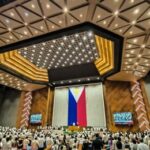MANILA – The Armed Forces of the Philippines (AFP) maintained that there is no brewing destabilization plot against the government among its ranks stemming from corruption issues surrounding flood control projects.
In an interview with reporters, AFP Public Affairs Office chief Col. Xerxes Trinidad insisted that claims on social media regarding the supposed plot are just “disinformation”.
“Definitely there are no plans of destabilization among the ranks of the AFP,” he said.
Trinidad called on the public to be very critical and discriminating when it comes to information circulating on social media, and to only source facts and details from credible sources.
“The AFP remains a disciplined and professional organization and we remain to be that kind of organization,” Trinidad said.
The AFP earlier cautioned the public against using soldiers for partisan agenda, affirming its commitment to upholding the Constitution and remaining loyal to the chain of command.
President Ferdinand R. Marcos Jr., through Executive Order 94, has created an independent fact-finding body to investigate the alleged irregularities in government flood control and other infrastructure projects.
Armed Forces of the Philippines
The Armed Forces of the Philippines (AFP) is the military organization of the Republic of the Philippines, established on December 21, 1935. It has a history rooted in the Philippine Revolution against Spain and was formally organized under the National Defense Act. The AFP is responsible for national security and has been involved in various conflicts, including World War II and ongoing internal security operations.
AFP Public Affairs Office
The AFP Public Affairs Office is the official communications and media relations arm of the Armed Forces of the Philippines. Its primary role is to inform the public about military operations, security issues, and the activities of the armed forces. This office has been instrumental in shaping the public narrative and maintaining transparency throughout the AFP’s history, including during significant events like counter-insurgency campaigns and national disasters.
Executive Order 94
Executive Order 94 is not a physical place or cultural site, but a U.S. presidential directive. Issued by President Harry S. Truman in 1947, it reorganized the structure of the U.S. military by establishing the Department of the Air Force as a separate branch, independent of the Army. This order was a key step in the creation of the modern U.S. Department of Defense.
government flood control projects
Government flood control projects are engineered infrastructure systems designed to manage water levels and prevent overflow in flood-prone regions. Historically, these have evolved from simple levees and canals to complex networks of dams, reservoirs, and diversion channels, often developed in response to major flooding events. These projects aim to protect communities, agriculture, and economic assets from the devastating impacts of floods.
infrastructure projects
Infrastructure projects are large-scale public or private constructions that develop foundational systems like transportation, energy, and water networks. Historically, they have been crucial for economic growth and societal development, from ancient Roman aqueducts and roads to modern initiatives like national highway systems and renewable energy grids. These projects are designed to enhance connectivity, support commerce, and improve quality of life for communities.
Constitution
“Constitution” most famously refers to the USS Constitution, a historic wooden-hulled frigate of the United States Navy. Launched in 1797, it earned the nickname “Old Ironsides” during the War of 1812 after cannonballs were seen bouncing off its strong live oak hull. It is the world’s oldest commissioned naval vessel still afloat and is now a museum ship in Boston, Massachusetts.
chain of command
“Chain of command” is not a physical place or cultural site, but a hierarchical organizational structure used in management and military operations. It describes the line of authority and responsibility along which orders are passed, ensuring clear communication and accountability. This concept has been fundamental to military organizations throughout history and is widely used in corporate and institutional structures today.
President Ferdinand R. Marcos Jr.
President Ferdinand R. Marcos Jr. is the 17th and current president of the Philippines, not a place or cultural site. He is the son of former President Ferdinand Marcos, whose 20-year rule was marked by martial law. His presidency represents a significant political comeback for the Marcos family.






